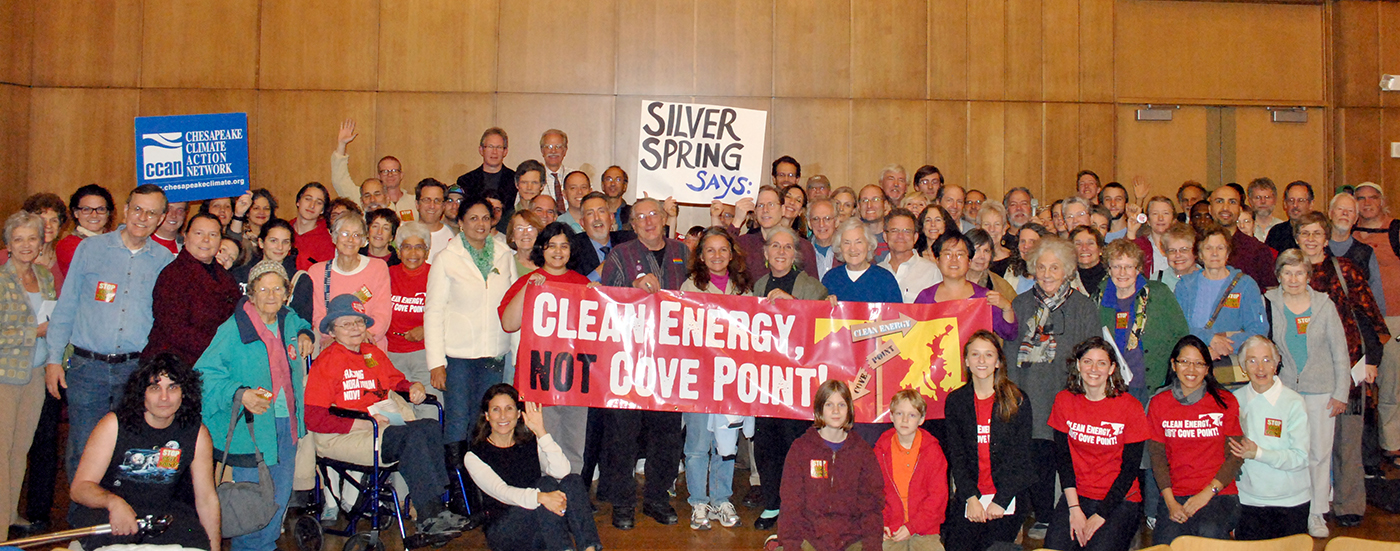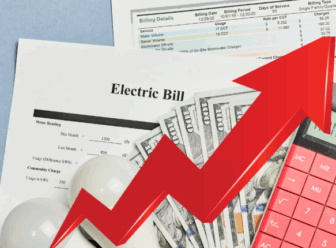The Maryland Crossroads campaign for “Clean Energy, Not Cove Point” is heating up. As is the planet. And energy giant Dominion is getting a little hot under the collar as well.
A statewide coalition of environmental, health, faith and public interest groups kicked off a nine-stop Maryland tour Tuesday, Nov. 5, to raise the alarm about a proposed $3.8 billion climate-killing facility on the shores of the Chesapeake Bay that would export liquefied fracked gas to India and Japan. With three stops completed, interest and opposition to the Cove Point plant in Calvert County are building. The first stop was Tuesday, Nov. 5, in Annapolis, where a big crowd turned out at Broadneck High School. This was followed by an even larger crowd packing a hall at St. Mary’s College on Wednesday, Nov. 6. Last night, Nov. 7, a packed room of nearly 250 people from across Montgomery County gathered at the civic center in downtown Silver Spring.
In addition, a Gonzales poll of Marylanders released Nov. 5 finds that a huge bipartisan majority, 81 percent, wants Dominion to conduct a comprehensive Environmental Impact Statement of the health, climate and safety hazards of the facility — rather than the less rigorous Environmental Assessment.
 It appears that the campaign is striking some nerves at Dominion. On Sunday, Nov. 3, it took out full-page ads in the Washington Post and Baltimore Sun to defend its plan. The ad says this country used its industrial might to become an “Arsenal of Democracy” and should do so again by building the Cove Point export plant for liquefied natural gas (LNG). Ironic, because the fossil fuels industry of late has been super busy buying our democracy and stifling science about climate change at every turn.
It appears that the campaign is striking some nerves at Dominion. On Sunday, Nov. 3, it took out full-page ads in the Washington Post and Baltimore Sun to defend its plan. The ad says this country used its industrial might to become an “Arsenal of Democracy” and should do so again by building the Cove Point export plant for liquefied natural gas (LNG). Ironic, because the fossil fuels industry of late has been super busy buying our democracy and stifling science about climate change at every turn.
Residents of Lusby, immediately adjacent to the proposed liquefaction plant in Calvert County, would be the first sacrificed under these plans. They would live with clogged highways, stored hazardous chemicals, as many as 90 additional thousand-foot long refrigeration tankers in the Chesapeake Bay, and the threat of a “BLEVE.” That’s the term that the Federal Energy Regulatory Commission (FERC) uses to describe the potential for a fireball “boiling-liquid-expanding-vapor explosion.” FERC wants more reassurances on that. So do we.
But the facility would also unleash a frenzy of fracking in the Marcellus Shale — perhaps in Maryland, where we still have a temporary moratorium while we study the health, economic and environment effects. That fracking frenzy would chop up our countryside into five-acre parcels, fragment our forests with snaking pipelines, and threaten our land, water and air with secret, toxic chemicals.
Exporting LNG is not the path to a safe climate. Those who argue that natural gas is a so-called bridge fuel because of its smaller CO2 footprint didn’t get the memo (or deliberately ignore the memo) that emissions of methane, the main component of natural gas, make fracking worse than coal for the climate. Indeed, the most recent Intergovernmental Panel on Climate Change (IPCC) report said methane is even more damaging than previously realized. It is 84 times stronger as a heat-trapping gas than CO2 is over 20 years and 28 times stronger over 100 years. (The ratios had been thought to be 72 and 25). Methane would leak at the drilling wellhead and all along the gathering lines and pipelines to that Cove Point plant. Although an industry-funded and controlled study found leakage rates at the drill site of 1 percent, NOAA-led scientists have found leaks of 6 percent to 12 percent, far above the 2 percent maximum that would make fracking acceptable in the emissions department – although still potentially disastrous for water, soil and air.
A U.N. Environment Program report this week said we are not reducing emissions nearly fast enough to avert climate disaster. Its Emissions Gap Report 2013 concluded that the pathway to keeping the global temperature increase to 2 degrees C will “swiftly diminish” by 2020 unless we do much more to reduce greenhouse gas pollution. With glaciers melting, seas rising, oxygen-supplying plankton dying, extinctions mounting, megastorms brewing and droughts persisting, 20 years might be all we’ve got, if that, to avoid catastrophic climate changes. The methane might dissipate in 15 or 20 years, but feared ecosystem tipping points, once reached, can’t be righted. That means this decade is our window for action. Actually, last decade would have been better.
We are at a crossroads. We should be turning far faster toward renewable energy. Shifting to fracking and exporting LNG is the wrong path for Maryland and the world.





